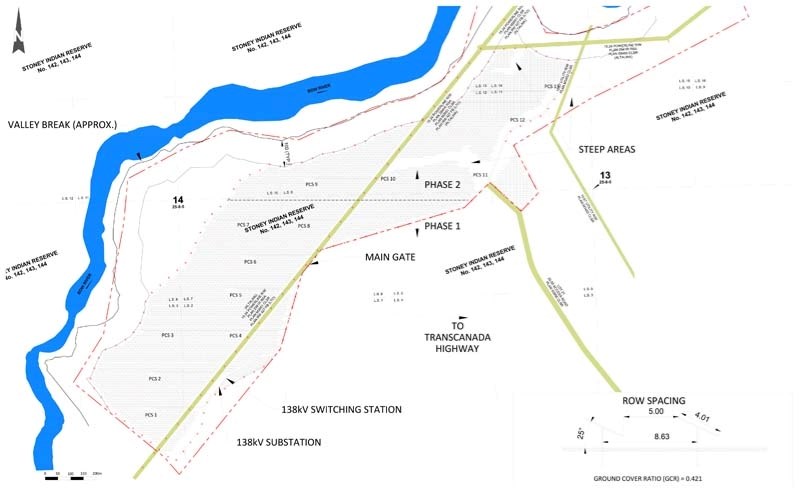The Chiniki First Nation is pushing forward with a 160-hectare solar energy project despite uncertainty over the potential building site.
In February, Stoney Nakoda Nation members voted no in a referendum asking to rezone reserve land – including the site for the solar project – to allow for more commercial development
A website, which was officially registered on Nov. 29, 2017, details the plan and anticipated regulatory approvals from the Alberta Utilities Commission (AUC).
An application for the construction and operation of the 25-megawatt solar power generation facility was also officially submitted to the AUC on March 13 – one month after the referendum.
The website lists several public consultation meetings including an open house on June 26, 2017. However, sources living on the reserve told the Cochrane Eagle they felt there has been little to no information provided about the project.
Chiniki Coun. Jordie Mark said his band wanted to wait for government approval before officially announcing the project to the community. Mark acknowledged any development on the parcel of land, which is located on the south side of the Bow River west of the Morley town site, would need to be approved by the community through a second referendum.
“We wanted to get our ducks in a row first,” said Mark. “We could have included it in the land designation (referendum), but we chose not to because we wanted something formal from the province.”
The Nation hopes the energy project will help the impoverished reserve create jobs and lead to more economic development.
“We wanted to go towards the renewable energy direction because the province is doing it, the world is doing it. Our oil and gas is not doing so well and eventually it’s going to be gone,” he said. “We wanted to think years ahead, something for our kids and their kids to depend on.”
The website also states the project is backed by the Chiniki First Nation working in partnership with Chiniki Trico Limited Partnership, which includes Canadian Solar Solutions Inc. as a developer.
All three organizations declined to comment or could not be reached for an interview.
Heather Carnahan, CEO for Stoney Nakoda Holdings, declined to comment about the project, but said back in February that it was too early to speculate about what types of development could occur if the community voted in favour of the referendum.
“One of the things that we’ve stressed with the community is that this is step one on the pathway to economic development planning,” said Carnahan ahead of the referendum.
“The next step after this is looking at the sites, working with the community and together figuring out what are the best things for these lands.”
Jim Law, director of external relations for the AUC, said he couldn’t comment on the specifics of the application, but said the AUC would thoroughly review the application to ensure it is complete and meets all the technical requirements.
“We review the application to determine whether on balance it’s in the public interest,” said Law, who declined to get into details about which technical requirements would have to be met for the application to be approved.
If the application is deemed complete the AUC will then issue a public notice.
“In that notice, we will let people in the area know that we’ve received the application, it’s complete and explain to them how they can participate in the process,” said Law, adding they typically host an information session in the area so people can learn about the project and ask questions.
“If there are any legitimate unresolved objections then that will trigger a public hearing, which is the formal court-like process,” Law said. “Following that formal process, the commission will take the input, the evidence and the testimony they’ve received from all the intervenors and the applicant, and generally within 90 days will make a decision on the project.”
Richard Feehan, Alberta minister of Indigenous Relations, said the province is committed to building a nation-to-nation relationship and does not interfere with local decisions.
“When they are ready to move ahead, we will be there to provide some assistance, support, direction because we absolutely have committed ourselves to the First Nations people being part of the new economy,” he said.
Acting tribal administrator Ken Christensen, acting Chiniki CEO Paul Chiasson and Chiniki Chief Aaron Young all declined to comment or could not be reached.
On Feb. 5, 10 days before the referendum, Young was pictured standing behind Margaret McCuaig-Boyd, the minister of energy, as she revealed more details about the next two rounds of the Renewable Electricity Program, which includes an indigenous partnership component to provide 300 megawatts of renewable power to First Nations communities.
Michael McKinnon, press secretary for the minister of energy, said neither the minister nor her department have discussed the proposed project.
According to the project’s website, phase one of construction is slated to begin as early as June with phase two to be completed by the end of the year.
Once completed, the solar park is expected to have a capacity of 40 megawatts – enough to power 6,500 homes per year with a 30-year life expectancy.
The proposed project is anticipated to cut 40,000 tonnes of CO2 and create a long-term cash flow for the Chiniki First Nation through operating profits and the long-term site lease. The project is also expected to create employment and training opportunities.




